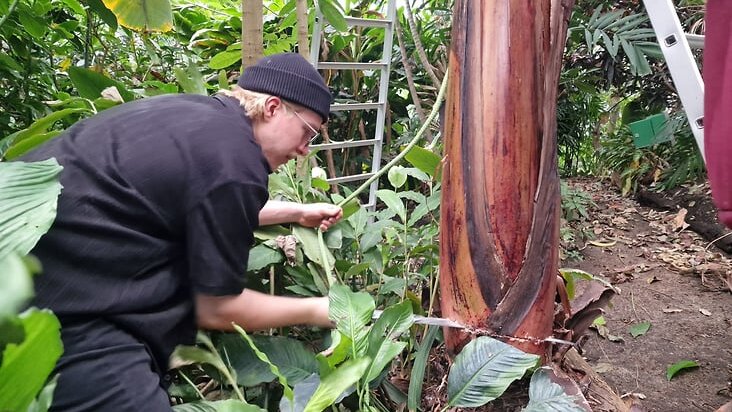As part of a collaborative project within the DFG-funded Collaborative Research Center TRR280, doctoral students Zirui Guo (doctoral student of Prof. Christoph Neinhuis) and Tom Morgenstern (doctoral student of Dr. Thea Lautenschläger) examined the pseudostems of banana plants in more detail. To do so, they took saws and ropes into the show greenhouses of the Botanical Garden. The aim of the cooperation project between the University of Hamburg and the Technical University of Dresden is to gain new insights into the impressive structure and mechanics of these plant-based lightweight wonders and to adapt them for new construction strategies.
Unique structure for stability and flexibility
The pseudostems of bananas consist of interlocking leaf stems that provide an impressive combination of stability and flexibility. The C-shaped cross-sectional structure of the petioles and large intercellular spaces in combination with longitudinally aligned cross walls ensure high rigidity with minimal weight and at the same time reversible deformability, for example in strong winds. What is particularly exciting is that these interlocking petioles are not freely movable. Even pulling off individual stems requires considerable force, which indicates that special adhesive or mechanical interactions strengthen the stability of the entire pseudostem.
The experiment: from the plant to the laboratory
A banana plant with a trunk height of over 5.30 meters was removed from the greenhouses of the Botanical Gardens in Planten un Blomen for the tests. The trunk was then transported to the Thünen Institute for Wood Research in Hamburg-Bergedorf. There, under the direction of Prof. Dr. Linnea Hesse and her colleagues Fabian Scheckenbach, Niklas Groth and Johannes Beruda from the Bionics Working Group of the Department of Biology at UHH, various biomechanical tests were carried out, including on a four-metre-long section of the banana. The experiments included bending load tests and compression loads as well as their photographic and videographic documentation.
Insight into the future
Research on these objects could not only help to deepen our understanding of natural structures, but also provide new approaches for technical applications in lightweight construction. Especially in the currently rapidly developing field of carbon fiber-reinforced concrete components, the fiber-rich pseudo-stems of the banana could offer new approaches for component geometries and carbon fiber arrangements.
Information on the Collaborative Research Center:
Since September 2024, the Botanic Garden of the University of Hamburg has been part of the Collaborative Research Center SFB/TRR280 “Construction strategies for material-minimized carbon structures - foundations for a new way of building” alongside TU Dresden and RWTH Aachen University. The project came to Hamburg and the Botanic Garden via Dr. Thea Lautenschläger, Scientific Director of the Hamburg Botanic Garden.





